
(Click on any image below for a larger version)
Wednesday, January 24: Andvord Bay
The Hanseatic was cruising close to the mountainous coast of the Antarctic Peninsula when I woke up the next morning. Glaciers filled all the valleys and topped the peaks of all the mountains. The only ice-free, rock surfaces were the cliffs facing the water in the fjord that we were sailing into. A gloomy overcast was suspended over the mountains.
The ship had entered Andvord Bay on the Antarctic Peninsula. Ice-capped mountains rose sharply from the water on both sides of the ship. The ship dropped anchor just a few hundred yards from the blue face of Arago Glacier, near Neko harbor at the end of the fjord. The glacier was flowing down a slope that was so steep that the ice had been broken into a jumbled icefall.
Debbie and I walked down the hall to the Marco Polo Restaurant to have breakfast. We were munching on lox and eggs when the broad back of a Minke Whale surfaced just a few yards outside the window. The whale blew a spout and gently submerged again. It continued to surface and blow several times as it moved slowly away from the ship. Another Minke Whale was spouting in the water near the base of the glacier.
 The Zodiacs landed on a bare rock point at the head of the bay. A
glacier was draped over the rock outcrop. The snow near the base
of the glacier was stained red and green by a bloom of ice algea.
The Zodiacs landed on a bare rock point at the head of the bay. A
glacier was draped over the rock outcrop. The snow near the base
of the glacier was stained red and green by a bloom of ice algea.
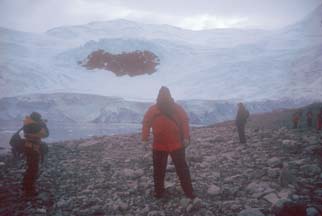 Brian
silhouetted against the ice of Arago Glacier.
Brian
silhouetted against the ice of Arago Glacier.
Andvord Bay was the prettiest stop on the cruise. There was beautiful scenery in all directions.
Every so often as we hiked around on the shore, we heard a sharp crack. Turning to look for the source of the sound, we saw chunks of ice tumbling into the water along the face of the glacier. Some of the falling ice raised waves that rolled outward from the icy wall.
 Blue sky could be seen through breaks in the clouds over the
distant mountains.
Blue sky could be seen through breaks in the clouds over the
distant mountains.
 The Hanseatic was anchored a short distance from the face of
Arago Glacier.
The Hanseatic was anchored a short distance from the face of
Arago Glacier.
 Panoramic
view of Andvord Bay.
Panoramic
view of Andvord Bay.
 There is a Gentoo Penguin rookery located on the rocks above the
beach.
There is a Gentoo Penguin rookery located on the rocks above the
beach.
 Gentoo Penguins were the only kind of penguin that we saw both in
the Falkland islands and the Antarctic.
Gentoo Penguins were the only kind of penguin that we saw both in
the Falkland islands and the Antarctic.
 Penguins were waddling into the shallow water off the beach.
Penguins were waddling into the shallow water off the beach.
 Adult Gentoo Penguins were waddling all over the ice-strewn
beach, but eventually they all worked their way to the rookery
farther up the hill near the foot of a small glacier. The chicks
were all located up at the rookery.
Adult Gentoo Penguins were waddling all over the ice-strewn
beach, but eventually they all worked their way to the rookery
farther up the hill near the foot of a small glacier. The chicks
were all located up at the rookery.
 A small wooden shack, painted orange, was
perched on the rocks above the shore. It was a refugio. The
Argentines had built it as a shelter for people stranded in the
harbor. It was equipped with bunks and supplies, but the floor
was rotting and partially collapsed. A Sheathbill had made its
nest under a wooden box next to the shack. Limpet shells littered
the ground in and around the nest.
A small wooden shack, painted orange, was
perched on the rocks above the shore. It was a refugio. The
Argentines had built it as a shelter for people stranded in the
harbor. It was equipped with bunks and supplies, but the floor
was rotting and partially collapsed. A Sheathbill had made its
nest under a wooden box next to the shack. Limpet shells littered
the ground in and around the nest.
 A pair of Weddell Seals cruised slowly past the Kelp Gulls along
the shoreline, unconcerned by the human activity on shore.
A pair of Weddell Seals cruised slowly past the Kelp Gulls along
the shoreline, unconcerned by the human activity on shore.
I was riding back to the Hanseatic from our landing in a Zodiac with Dad and Elaine, and Arte Johnson and his wife, Gisela, when the glacier dropped an iceberg into the water about 1/4 mile from us. I had just put away my video camera to prepare to climb onto the gangway. I thought that we might get swamped by the wave, so I left my camera in the bag until the waves were past. Mrs. Johnson still had her camera out and had the presence of mind to get some pictures of the ice fall.
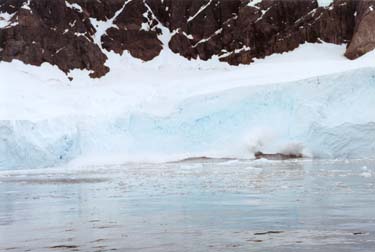 The
iceberg raised a tall breaking wave. Photo courtesy Gisela
Johnson.
The
iceberg raised a tall breaking wave. Photo courtesy Gisela
Johnson.
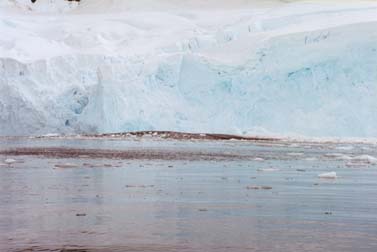 The
wave was capped with chunks of ice that were bigger than our
boat. Photo courtesy Gisela Johnson.
The
wave was capped with chunks of ice that were bigger than our
boat. Photo courtesy Gisela Johnson.
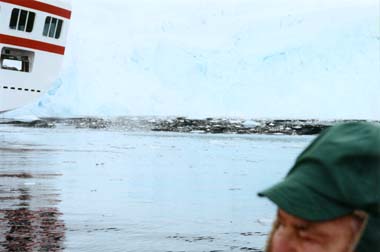 Captain Notke blew a long blast on the ship's horn to warn
everybody in boats and on shore. People loading into a Zodiac on
the side of the ship facing the glacier had to quickly run back
up the gangway, and the driver hurriedly maneuvered the Zodiac
around to the other side of the ship. Photo courtesy Gisela
Johnson.
Captain Notke blew a long blast on the ship's horn to warn
everybody in boats and on shore. People loading into a Zodiac on
the side of the ship facing the glacier had to quickly run back
up the gangway, and the driver hurriedly maneuvered the Zodiac
around to the other side of the ship. Photo courtesy Gisela
Johnson.
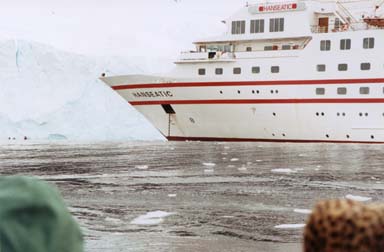 Heinrich, our zodiac driver, headed for shelter behind the
Hanseatic. The waves hit the Hanseatic before they reached us.
The ship bobbed like a toy boat. First the wave lifted its bow.
The gangway on the starboard side of the ship was submerged.
Water reached the sill of the door into the ship, which was on
the deck above the lower row of portholes that are visible in
this picture. People in the crew's quarters would have seen green
water outside their portholes for several seconds. Photo courtesy
Gisela Johnson.
Heinrich, our zodiac driver, headed for shelter behind the
Hanseatic. The waves hit the Hanseatic before they reached us.
The ship bobbed like a toy boat. First the wave lifted its bow.
The gangway on the starboard side of the ship was submerged.
Water reached the sill of the door into the ship, which was on
the deck above the lower row of portholes that are visible in
this picture. People in the crew's quarters would have seen green
water outside their portholes for several seconds. Photo courtesy
Gisela Johnson.
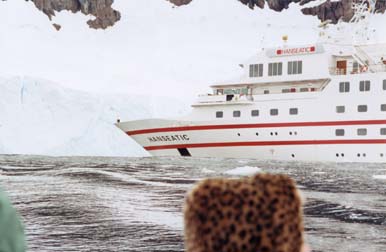 The
bow of the Hanseatic slipped down into the trough behind the
first wave, raising its stern out of the water. Photo courtesy
Gisela Johnson.
The
bow of the Hanseatic slipped down into the trough behind the
first wave, raising its stern out of the water. Photo courtesy
Gisela Johnson.
 When
the first wave reached our Zodiac, it was a really huge appearing
swell with a very steep face. When we were in the trough of the
swells, the crests loomed over our heads, but the Zodiac rode
smoothly over the waves, and we didn't get swamped at all. Photo
courtesy Gisela Johnson.
When
the first wave reached our Zodiac, it was a really huge appearing
swell with a very steep face. When we were in the trough of the
swells, the crests loomed over our heads, but the Zodiac rode
smoothly over the waves, and we didn't get swamped at all. Photo
courtesy Gisela Johnson.
 Several large swells lifted and dropped our
zodiac before the waters of the harbor calmed down. I pulled out
the video camera and resumed shooting after the first couple of
waves had passed us.
Several large swells lifted and dropped our
zodiac before the waters of the harbor calmed down. I pulled out
the video camera and resumed shooting after the first couple of
waves had passed us.
We could see the waves breaking on the shore that we had just departed. People arriving in a Zodiac on the beach had to run for high ground. The driver of that Zodiac turned it around just in time to meet a tsunami that tipped the bow of his boat up almost to the vertical.
Heinrich brought us to the launching platform, and we climbed back onto the ship.
 Very
soon the ship was surrounded by slush ice that prevented the
other zodiacs from docking.
Very
soon the ship was surrounded by slush ice that prevented the
other zodiacs from docking.
 Captain Notke slowly turned the ship around and moved away from
the glacier, so that the other zodiacs could bring their
passengers back aboard.
Captain Notke slowly turned the ship around and moved away from
the glacier, so that the other zodiacs could bring their
passengers back aboard.
 Passengers in one Zodiac were treated to a close examination of
the brand new iceberg. Later, it was stated that the Hanseatic
had never been anchored so close to a calving iceberg.
Passengers in one Zodiac were treated to a close examination of
the brand new iceberg. Later, it was stated that the Hanseatic
had never been anchored so close to a calving iceberg.
 An
iceberg-sized chunk of ice fell away from a glacier at the top of
a mountain above the bay. It was broken into small bits as it
fell down the rocky face. The ice bits followed the channels in
the rocks and eventually streamed over the glacier at the bottom
of the cliff into the water of the bay. The ice piled up like a
giant snow cone on the water.
An
iceberg-sized chunk of ice fell away from a glacier at the top of
a mountain above the bay. It was broken into small bits as it
fell down the rocky face. The ice bits followed the channels in
the rocks and eventually streamed over the glacier at the bottom
of the cliff into the water of the bay. The ice piled up like a
giant snow cone on the water.
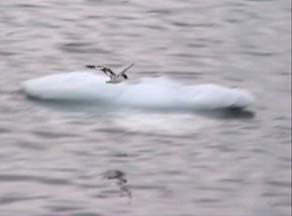 Small, black and white Cape Petrels cruised low over the dark
water around the ship.
Small, black and white Cape Petrels cruised low over the dark
water around the ship.
There were a several Minke Whales in the harbor with us.
 Throughout the afternoon, the Minke Whales surfaced regularly a
few hundred yards from the ship. They did not appear to be moving
very quickly. They just surfaced, blew, and then submerged again
leaving a circular footprint and almost no wake.
Throughout the afternoon, the Minke Whales surfaced regularly a
few hundred yards from the ship. They did not appear to be moving
very quickly. They just surfaced, blew, and then submerged again
leaving a circular footprint and almost no wake.
 Every so often one of them would lift its flukes out of the water
as it began a particularly deep dive.
Every so often one of them would lift its flukes out of the water
as it began a particularly deep dive.
 The anchor was lifted and we
cruised slowly back out of the bay.
The anchor was lifted and we
cruised slowly back out of the bay.
 Our landing was made on the light
colored rocks just to the right of the center of the picture.
Our landing was made on the light
colored rocks just to the right of the center of the picture.
 Panoramic view looking back toward Neko Harbor.
Panoramic view looking back toward Neko Harbor.
 The small bits of ice floating in
the bay snapped and crackled surprisingly loudly in the sunlight,
sounding like a big bowl of Rice Crispies.
The small bits of ice floating in
the bay snapped and crackled surprisingly loudly in the sunlight,
sounding like a big bowl of Rice Crispies.
 This fresh iceberg hadn't developed much of an indentation at the
waterline yet.
This fresh iceberg hadn't developed much of an indentation at the
waterline yet.
 Map of the West Coast of the
Antarctic Peninsula.
Map of the West Coast of the
Antarctic Peninsula.
 Table of
Contents
Table of
Contents Send a message to Brian.